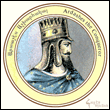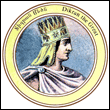| The Persian dominance |
In 612 BC the Medes destroyed Nineveh and brought the Assyrian power to an end. Armenia's eternal antagonist abandoned the political arena. Some 50 years later, the king Tigranes the First in alliance with Cyrus the Great, founder of Achaemenid dynasty conquered the lands controlled by the Medes and reinforced the Armenian kingdom.
Tigranes the First had 3 sons; the third son's name was Vahagn the Dragonfighter. The Armenian pagan tradition covered this Vahagn with glory and legends: he was even deified and worshipped like Hercules.
However, the era of peace ended as a number of weak and insignificant kings ruled Armenia over the following years, and finally the country became tributary to Persia. An inscription on a rock (around 520 BC) called the Behestun Stone, found in Iran, mentions Armenia in the list of countries Darius I controlled. The dynasty of Hayk stopped: the kings of Armenia were henceforward anointed by the Persian kings. During the following centuries the Armenian troops fought for Persia in all major battles. The Armenian cavalry was well known for its valor. Vahe, the last offspring of Hayk dynasty, was killed in 331 BC, fighting for Darius in a battle against Alexander the Great. |
Armenia regains independence |
 Armenia regained independence after the death of Alexander the Macedonian, when the monarchy of the latter was split into many parts. By 190 BC, Prince Artashes, the governor of Greater Armenia, united the shattered Armenian lands, establishing the Atashesian dynasty. He built the city of Artashat. According to some Roman historians, the construction of this new Armenian capital was supervised by famous commander Hannibal the Carthaginian, who took refuge in Armenia fleeing from the Romans. Armenia regained independence after the death of Alexander the Macedonian, when the monarchy of the latter was split into many parts. By 190 BC, Prince Artashes, the governor of Greater Armenia, united the shattered Armenian lands, establishing the Atashesian dynasty. He built the city of Artashat. According to some Roman historians, the construction of this new Armenian capital was supervised by famous commander Hannibal the Carthaginian, who took refuge in Armenia fleeing from the Romans.
The country enjoyed peace and prosperity under the rule of Vagharshak, who came to throne in 149 BC. He set up the institute of nobility in his kingdom and established the new senior official ranking system. Vagharshak made the city of Armavir his royal residence. Several Greek inscriptions from around that period found in Armavir witness about the influence of the Greek culture in Armenia. |
Ara the Beautiful |
| Aram's son, Ara the Beautiful succeeded him. A very romantic Armenian legend tells that Ara was so handsome that the Assyrian Queen Semiramis (the same who founded Babylon and planted its marvelous hanging gardens) fell in love with him. Ara repeatedly rejected her love proposals until the desperate queen began war with him. The Assyrians troops won the furious battle, and Ara was killed, in despite of Semiramis's order to preserve his life. Inconsolable Semiramis reputed to be sorceress took his body and tried in vain to enliven him. When Armenians advanced to avenge their leader, she disguised one of her lovers and spread the rumor that Gods brought Ara back to life. As a result, the war was ceased. |
Tigranes the Great |
 Vagharshak's son Arshak and his grandson Artashes were very successful rulers as well, but it was perhaps the son of the latter, Tigranes II, who distinguished himself as the most glorious among all Armenian kings. He succeeded his father in 95 BC. Brother-in-law and true ally of Mithridates the Great, the glorious King of Pontus, he struggled together with his formidable relative against the Roman dominance. Tigranes the Second also known as Tigranes the Great, extended the Armenian borders from Caspian Sea to Egypt, gaining full control over the vast territories. After having subdued the Vagharshak's son Arshak and his grandson Artashes were very successful rulers as well, but it was perhaps the son of the latter, Tigranes II, who distinguished himself as the most glorious among all Armenian kings. He succeeded his father in 95 BC. Brother-in-law and true ally of Mithridates the Great, the glorious King of Pontus, he struggled together with his formidable relative against the Roman dominance. Tigranes the Second also known as Tigranes the Great, extended the Armenian borders from Caspian Sea to Egypt, gaining full control over the vast territories. After having subdued the  provinces in Syria, Cappadocia and Mesopotamia, Tigranes also conquered Palestine, taking many thousands of prisoners. He united all the Armenian lands and built 4 large cities in different parts of his empire all 4 called Tigranakert. provinces in Syria, Cappadocia and Mesopotamia, Tigranes also conquered Palestine, taking many thousands of prisoners. He united all the Armenian lands and built 4 large cities in different parts of his empire all 4 called Tigranakert.
Just like his father Artashes, Tigranes transported from Greece many statues of the Greek Gods. A gigantic statue of Zeus was erected in Ani fortress, and sanctuary for Anahit (Aphrodite) was raised in the city of Ashtishat. |
Roman and Parthian invasions |
Tigran's expansion ended with the Roman and Parthian advances. In 69 BC,the troops of the Roman general Lucullus invaded Armenia and besieged Tigranakert.The city fell, betrayed by a Greek garrison. The Romans set the city ablaze. Many architect treasures including fine statues, temples and a splendid theater were demolished and lost in the fire.
At the same time, the Parthian army attacked the city of Artashat. The Partians were led by the treasonous son of Tigranes, who joined his father's enemy after marrying the Parthian princess. Battling on two fronts, Tigranes the Great defeated the Parthian army. Soon Lucullus was forced to turn back as well, facing the Armenian counterattacks. However, the Romans launched a new offensive expedition, under Pompey the Great. Tigranes, at time 75-year-old, was forced to sign a peace treaty. As a result, several lands were yielded to Rome, but the country and Tigranes's power remained strong. |
Artavazd |
 Tigranes the Great died in 55 BC. Subsequently his son Artavazd ruled Armenia. Adept of ellenistic culture, Artavazd wrote plays and poems in Greek. The Greek tragedies were performed in his royal residence of Artashat on a regular basis. Historians testify that the head and the right hand of Crassus, the eminent Roman commander killed in a battle against the joint Persian and Armenian armies, was brought to Artavazd while he was enjoying the play of Euripide's Bacchantes. Tigranes the Great died in 55 BC. Subsequently his son Artavazd ruled Armenia. Adept of ellenistic culture, Artavazd wrote plays and poems in Greek. The Greek tragedies were performed in his royal residence of Artashat on a regular basis. Historians testify that the head and the right hand of Crassus, the eminent Roman commander killed in a battle against the joint Persian and Armenian armies, was brought to Artavazd while he was enjoying the play of Euripide's Bacchantes.
The ruling of Artavazd was unsuccessful: he lost many of the lands that Tigranes, his glorious father, had conquered. Marcus Antonius captured the Armenian King, shackled him and took to Egypt as a present to Cleopatre. With haughtiness, Artavazd refused to greet Cleopatre, and was decapitated. Armenia became a vassal state of the Roman Empire. |
Abgar and the First Baptism |
Under the ruling of the aged Abgar, nephew of Tigranes the Great, the whole territory of Armenia was subdued to Rome. The Roman officials arrived to Armenia to take a census. They brought with them numerous statues of the Emperor Augustus.
Later, Abgar, planning to revolt against the Roman tyranny, settled in Mesopotamia and founded the city of Edessa. He transported there his court, the treasury, and the archives of the Armenian kings. That is why the Armenian sources designate him as King of Armenia while some Greek and Roman sources mention Abgar, ruler of Edessa. When Abgar heard about the miracles Jesus Christ was performing in  Galilee, he was already ailing, in his declining years. Astonished, he came to believe in Christ and wrote a letter to Him. Abgar asked the Savior to heal him and invited Him to Edessa. Galilee, he was already ailing, in his declining years. Astonished, he came to believe in Christ and wrote a letter to Him. Abgar asked the Savior to heal him and invited Him to Edessa.
Abgar's messengers met Jesus in Jerusalem. Jesus would not accept the offer to visit Edessa, but wrote a response to Abgar's request. After Christ's ascension Thaddaeus, one of the disciples, arrived to Edessa bringing a piece of cloth that some researchers identify as the Shroud of Turin. According to Moses of Khorene, Abgar and all inhabitants of his city were baptized. |
пїЅ ArmenianHistory.info |
|
|










